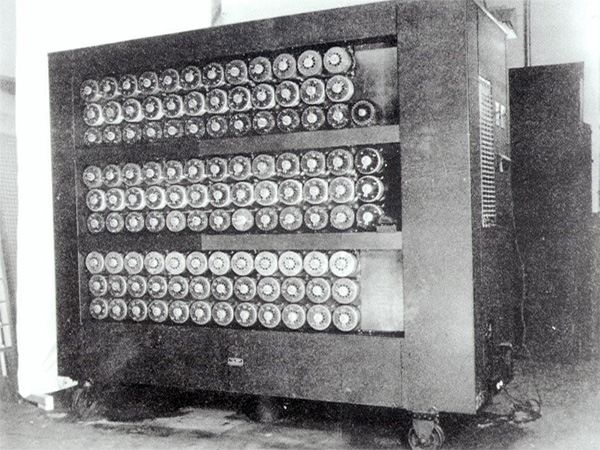
Turing Machines Explained [Video]
Video uploaded by Computerphile on August 29, 2014
Power of Computers – Excerpt from Darwin Among the Machines by George Dyson
The power of computers – whether the strictly regulated machinations of a Turing machine or the amorphous intelligence residing in our heads – derives from their ability to form maps between sequence, arranged in time, and structure, arranged in space. Memory and recall, no matter what their form, are translation between these two species of bits. “Memory locations,” according to Danny Hillis, “are just wires turned sideways in time.” In the correspondence between sequence and structure lies the basis not only of computation and memory, but also of organic life, based on the translation of sequences (nucelotides) into structures (proteins), with natural selection the mechanism for debugging the source code and translating improvements back from the structure of the organism to the sequence of its genes. Computers are speeding the process up.
In Alan Turing’s minimal example, translation between structure and sequence is executed one bit at a time. The Turing machine scans one square on its tape, reads one bit of information, makes a corresponding change in its state of mind, and, in accordance with its instructions, writes or erases one bit of information on its tape. When the next moment arrives, it goes through this process again, The Turing machine and its visible universe cross paths one symbol at a time.
As bandwidth measures the capacity to communicate information from one place to another, so it is possible to assign a magnitude to the amount of information that a Turing machine or another organism is able to scan as it moves from one moment to the next. Extending Turing’s terminology, we may call this the machine’s depth of mental field. Going one step further, it is possible to quantify how much information can be scanned at a single moment, multiplied by the number of consecutive moments that can be comprehended within the machine’s state of mind. This scale of mental capacity allows us to make comparisons between minds that may be operating at completely alien velocities in time.
In the four-dimensional universe of space and time, we are confined to a three-dimensional surface. Only one moment exists in our reality, the existence of other moments is evident only through the constructs of our mind. We breathe one lifetime at a time within a thin atmosphere condensed our of the surrounding sequence of events. All our devices for translating, between sequence and structure serve to extend this atmospheric depth – the history of life on earth is compressed within sequential strands of DNA; culture is accumulated in the form of language; somehow our brains preserve the sequence of our lives from one moment to the next. As far as we know, mind and intelligence exist on an open-ended scale. Perhaps mind is a lucky accident that exists only at our particular depth of field, like some alpine flower that blooms between ten thousand and twelve thousand feet. Or perhaps there is mind at elevations both above and below our own.

Turing Machine – 1936
“It may be that the cells of which we are built up… each one of them with a life and memory of its own… reckon time in a manner inconceivable to us,” suggested Samuel Butler in 1877. ‘If, in like a being as much in need of a microscope for our time and affairs as we for those of our own component cells, the years would be to such a being but as the winkings or the twinklings of an eye.” Writing in Life and Habit on the eve of his estrangement from Charles Darwin, Butler sought to encompass Darwinism – from the life of germs to the germination of species – within a framework of all-pervasive mind. “What I wish is, to make the same sort of step in an upward direction which has already been taken in a downward one, and to show reason for thinking that we are only component atoms of a single compound creature, LIFE, which has probably a distinct conception of its own personality though none whatever of ours.”
Olaf Stapledon believed that the mind of the individual and the mind of the species need not remain estranged. “Our experience was enlarged not only spatially but temporally in a very strange manner,” explains the narrator of Last and First Men, concerning the composite mind toward which our species had inexorably evolved. ‘in respect of temporal perception, of course, minds may differ in two ways, in the length of the span which they can comprehend as “now”, and in the minuteness of the successive events which they can discriminate within the “now.” As individuals we can hold within one “now’ a duration equal to the old terrestrial day; and within that duration, we can if we will, discriminate rapid pulsations such as commonly we hear together as a high musical tone. As the race-mind we perceived as “now” the whole period since the birth of the oldest living individuals, and the whole past of the species appeared as personal memory, stretching back into the mist of infancy. Yet we could, if we willed, discriminate within the “now” one light-vibration from the next.”
Both Samuel Butler and Olf Stapledon saw that mind, once given a taste of time, would never rest until eternity lay within its grasp. Thus we pursue those relations between sequence and structure that allow us to escape time’s surface, venturing into that ocean that separates eternity from the instant in which we exist.
Excerpt from Darwin among the machines by George Dyson.
Links
- Looking for the place to sell your old computer? Get free quote at iGotOffer.com – the best place to sell used electronics online
- Everything About Apple’s Products – The complete guide to all Apple consumer electronic products, including technical specifications, identifiers and other valuable information.
- Everything About Microsoft’s Products – The complete guide to all Microsoft consumer electronic products, including technical specifications, identifiers and other valuable information.






Facebook
Twitter
RSS